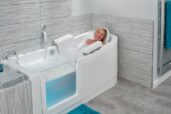A third of UK households are multi-generational according to the 2020 edition of Aviva’s How We Live Report, with older relatives accounting for 14% of all multi-generational households. The 2016 version of the same report series recorded that older relatives accounted for 9% of multi-generational households so a significant increase over 4 years.
This trend is set to continue as 7% of householders surveyed by Aviva said that they had plans to develop additional multi-generational living space at their current property. Of those respondents, 27% said they were planning to use this to accommodate their elderly relatives.
However, not all of us have the space or finances to create a separate granny flat for our elderly parents or a graddy flat for our grown up children, so what are the options? One more affordable route is to adapt what you already have. Children might be convinced to sleep in bunk beds in the same room and a family bathroom can be overhauled to make it suitable for people of all ages to use, though the latter is a more involved project, and may benefit from the support and guidance of an accessible bathroom installer such as Absolute Mobility.
How do you design a bathroom for a multi-generational home?
Having two or even three generations living under the same roof means compromises will need to be made, and one room where this can prove difficult, is the bathroom. The family bathroom might host bath time for infants and showers for an elderly relative with osteoarthritis, whilst also acting as an occasional haven of calm for middle-aged people in the middle. So where do you start?
Considering every bodies individual bathing needs is paramount, but in general those with mobility difficulties should be prioritised when designing a multi-generational bathroom. You also need to consider how long the living arrangement is likely to last. Is it temporary or likely to be more long term?
Over the years we have seen many design innovations which have made easier to design a multigenerational bathroom that truly works. We have compiled these into a list of tips below, if these resonate, we suggest reaching out to a few mobility bathroom specialists for a design consolation and quote.
Unwind in a walk-in shower bath with integrated bath lift
There are different types of walk-in baths available, including tub-style walk-in baths that are typically shorter in length and have an upright seating position, standard walk-in baths that resemble a traditional bath with a door, and walk in shower baths that do double duty as both a shower and full-length bath.
This final category may be more suitable for many multi-generational bathrooms where the older bathers are likely to be comfortable standing in the shower for a number of years to come. Some contemporary designs such as the Indiana walk-in shower bath with a stylish p-shaped design. The unit features a wide door with low threshold making it easier to enter and exit the bathing area. It is available with the option of a powered seat which can lower those with mobility issues down into the water.
The benefit of selecting a bath is the younger bathers can also enjoy a soak in warm water which calms them before their bedtime, and their parents can take some me time with their favourite book once everybody else is tucked up in bed.
Warm your feet and save space with underfloor heating
Underfloor heating is a popular solution that not only keeps your bathroom warm but also saves space. Unlike traditional radiators that take up valuable wall space, underfloor heating is installed beneath the floor and evenly distributes heat throughout the room. This type of heating system is particularly beneficial for those with limited space or for rooms with awkward layouts where radiators may be impractical. Underfloor heating also provides a more consistent and comfortable temperature distribution compared to radiators.
Anti-slip tiles as a stylish alternative to vinyl
Whilst the utility of vinyl flooring is undeniable, it can make a room feel a bit clinical. Anti-slip floor tiles are a more expensive but also more stylish alternative, they work very well with underfloor heating too, as long as the correct adhesive is used. Be sure that you specify tiles that are both safe and smart. Tiles are available in different R ratings. The R12 rating indicates that a tile has a high level of slip resistance, making them ideal for wet areas such as multi-generational bathrooms reducing the risk of accidents and falls.
Rehang the bathroom door to open on to the hallway
The accessibility and ease of use of a bathroom can be greatly improved by rehanging the door to open outwards. This change in design creates more space inside the bathroom, making it easier for elderly bathers using a walking frame to enter and exit. Beyond that, an outward opening door eliminates the risk of blocking access or becoming an obstacle within the bathroom.
Automatic lights for night time visits
It is a fact of life that both children and the elderly tend visit the bathroom quite often at night. Motion sensor lights automatically turn on when someone enters the bathroom, providing illumination without the need for fumbling in the dark for light switches. This feature is particularly important for the young and elderly who may have difficulty navigating a bathroom at night, making it easier to see and again reducing the risk of accidents and falls.
Smart hygiene with a combined toilet bidet and dryer
Automatic shower toilets are an all-in-one type of sanitaryware that combines the functionality of a toilet, a bidet and a dryer and is a fantastic solution that can support more independent living. They use water for cleaning after using the toilet, and a dryer, which removes the need for toilet paper and hand contact. Some are also available in a comfort height version which means elderly relatives will not have to bend their legs as much to sit down. If young children also need to use the facilities then you may need to invest in small removable step so they can easy use it too.
Choose a wet room design for long-term flexibility
If the youngest members of your family are more into Stranger Things than Bob the Builder then you may not need to install a bath in your multi-generational bathroom. In that case an walk-in wet room may offer more flexibility. A key advantage of this choice is that a bathing space can be created with zero threshold. This means that users of wheelchairs and other walking aids can get right into the bathing area, without needing to transfer to another device.
Pre-heat your shower from your smartphone
Some intelligent digital shower units such as the AKW I-Care Electric Shower offer the option to control your shower from either a remote control or a smartphone app.
You can adjust the water temperature, water flow, and in some cases the type of spray at the touch of a button. This allows the shower to get up to temperature while the bather gets changed, preventing them from getting wet when it is initially turned on. The thermostatic controls ensure that the water is never too warm or cold if set correctly. Some units even remember previous temperature settings.
Stylish grab bars in contrasting colours
Grab bars are important for individuals with limited mobility as they offer stability and support whilst navigating in the bathroom. Design wise, they are no longer limited to a glossy white color like in hospitals. Various finishes, like matte black, are now available. Specifying grab bars in contrasting colours, such as matte black against a light grey wall tile not only improves their visibility, but also adds style to the overall bathroom design.
Hygienic contactless flushing
In a house full of people one of the most important factors in overall wellbeing is going to be hygiene. Both the young and the elderly are generally more vulnerable to getting unwell. For this reason, contactless cistern flush valves could be valuable addition to your multi-generational bathroom design. They use infrared technology that can detect a waving hand and automatically flush the toilet without the need for physical contact. This contactless feature is not only cleaner, but is more easy to use for people with arthritis or other conditions affecting the hands. As an additional bonus, these valves are sometimes programmable, allowing the amount of water per second and duration to be changing, potentially making them more efficient compared to traditional systems.
All of the tips in this article are to provoke thoughts and ideas for the design process of a bathroom adaptation. We recommend that you always seek the advice of an accessible bathroom design and installation business such as when undertaking a bathroom adaptation. A free home visit is all that is takes to generate a custom design quotation for multi-generational bathroom that not only stylish, but safe and futureproof.
6 February,2024








